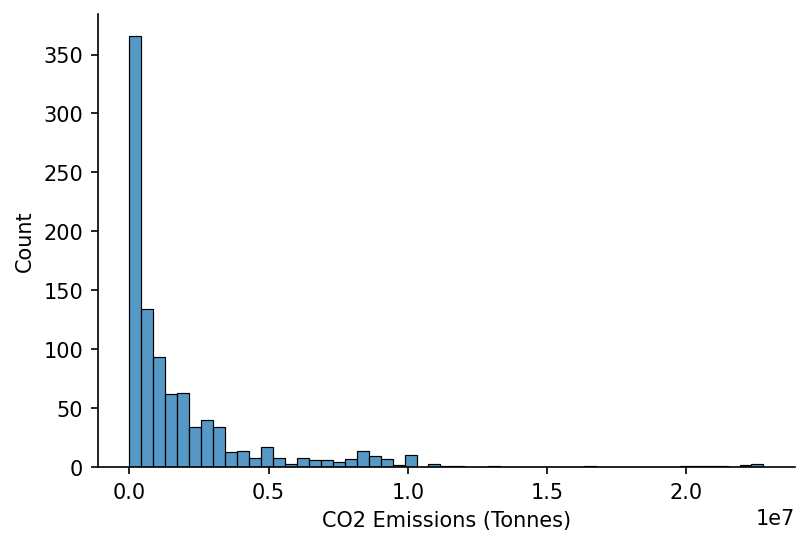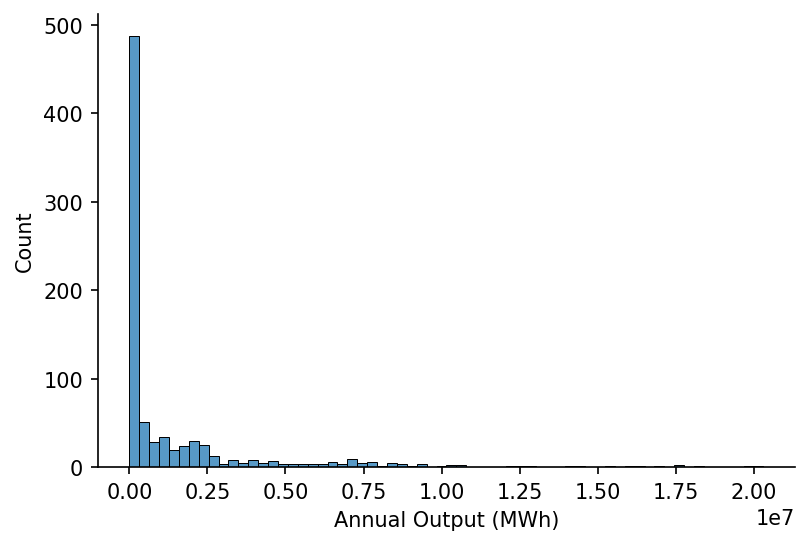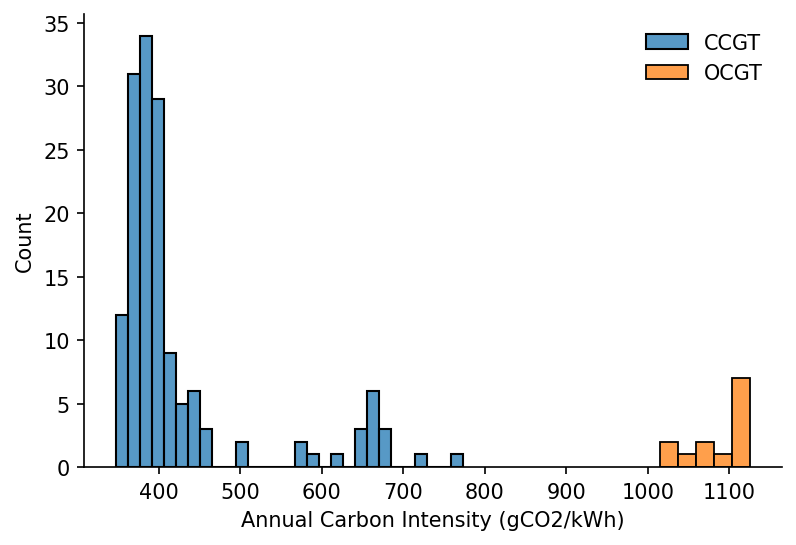Carbon Intensity¶
import numpy as np
import pandas as pd
import seaborn as sns
import matplotlib.pyplot as plt
Data Preparation¶
We'll start by loading the dictionary’s attribute data. This data has been automatically extracted from other datasets which have been linked to assets in the dictionary.
attributes_fp = 'https://osuked.github.io/Power-Station-Dictionary/object_attrs/dictionary_attributes.csv'
df_attrs = pd.read_csv(attributes_fp)
df_attrs.head()
| attribute | id | value | datapackage | id_type | year | dictionary_id | financial_year |
|---|---|---|---|---|---|---|---|
| Fuel Type | MARK-1 | BIOMASS | https://raw.githubusercontent.com/OSUKED/Dicti... | ngc_bmu_id | nan | 10000 | nan |
| Longitude | 10000 | -3.603516 | https://raw.githubusercontent.com/OSUKED/Dicti... | dictionary_id | nan | 10000 | nan |
| Latitude | 10000 | 57.480403 | https://raw.githubusercontent.com/OSUKED/Dicti... | dictionary_id | nan | 10000 | nan |
| Annual Output (MWh) | MARK-1 | 355704.933 | https://raw.githubusercontent.com/OSUKED/Dicti... | ngc_bmu_id | 2016 | 10000 | nan |
| Annual Output (MWh) | MARK-1 | 387311.364 | https://raw.githubusercontent.com/OSUKED/Dicti... | ngc_bmu_id | 2017 | 10000 | nan |
We'll then extract the CO2 emissions data
def hide_spines(ax, positions=["top", "right"]):
"""
Pass a matplotlib axis and list of positions with spines to be removed
args:
ax: Matplotlib axis object
positions: Python list e.g. ['top', 'bottom']
"""
assert isinstance(positions, list), "Position must be passed as a list "
for position in positions:
ax.spines[position].set_visible(False)
co2_attr = 'CO2 Emissions (Tonnes)'
s_site_co2 = (
df_attrs
.query('attribute==@co2_attr')
[['dictionary_id', 'year', 'value']]
.dropna()
.astype({'dictionary_id': int, 'year': int, 'value': float})
.groupby(['dictionary_id', 'year'])
['value']
.sum()
)
# Plotting
fig, ax = plt.subplots(dpi=150)
sns.histplot(s_site_co2, ax=ax)
ax.set_xlabel(co2_attr)
hide_spines(ax)

As well as the power output data
output_attr = 'Annual Output (MWh)'
s_site_output = (
df_attrs
.query('attribute==@output_attr')
[['dictionary_id', 'year', 'value']]
.dropna()
.astype({'dictionary_id': int, 'year': int, 'value': float})
.groupby(['dictionary_id', 'year'])
['value']
.sum()
)
# Plotting
fig, ax = plt.subplots(dpi=150)
sns.histplot(s_site_output, ax=ax)
ax.set_xlabel(output_attr)
hide_spines(ax)

And lastly the fuel types of each plant
fuel_attr = 'Fuel Type'
s_site_fuel_type = (
df_attrs
.query('attribute==@fuel_attr')
[['dictionary_id', 'value']]
.dropna()
.astype({'dictionary_id': int, 'value': str})
.groupby('dictionary_id')
['value']
.agg(lambda fuel_types: ', '.join(set(fuel_types)))
)
s_site_fuel_type.value_counts()
WIND 112
CCGT 34
NPSHYD 13
NUCLEAR 7
OCGT 4
PS 4
CCGT, OCGT 3
BIOMASS 3
COAL, OCGT 1
CCGT, COAL, OCGT 1
Wind 1
BIOMASS, OCGT, COAL 1
OTHER 1
Name: value, dtype: int64
Calculating Annual Carbon Intensities¶
We'll quickly check the data coverage
sites_with_co2_data = s_site_co2.index
sites_with_output_data = s_site_output.index
sites_with_both_datasets = sites_with_co2_data.intersection(sites_with_output_data)
sites_with_co2_data.size, sites_with_output_data.size, sites_with_both_datasets.size
(978, 825, 239)
sites_with_both_datasets.get_level_values(0).unique().size
52
We're now ready to calculate the annual carbon intensities
s_site_carbon_intensity = 1000 * s_site_co2.loc[sites_with_both_datasets]/s_site_output.loc[sites_with_both_datasets]
s_site_carbon_intensity
dictionary_id year
10002 2016 856.556931
2017 849.483513
2018 933.703289
2019 918.491921
2020 3368.789243
...
10104 2016 1104.226297
2017 1110.856183
2018 1103.122391
2019 1125.497186
2020 1070.007876
Name: value, Length: 239, dtype: float64
We'll identify which sites we also have matched fuel type information for
s_site_fuel_type_mod = s_site_fuel_type.copy()
s_site_fuel_type_mod[s_site_fuel_type.str.contains(', ')] = 'MIXED'
s_site_fuel_type_mod = s_site_fuel_type_mod.replace('Wind', 'WIND')
sites_with_relevant_fuel_types = s_site_fuel_type_mod[s_site_fuel_type_mod.isin(['CCGT', 'OCGT', 'BIOMASS', 'MIXED'])].index
sites_with_relevant_fuel_types.size
47
We'll now filter for only thermal generation
s_site_focus_carbon_intensity = s_site_carbon_intensity.loc[s_site_carbon_intensity.index.get_level_values(0).isin(sites_with_relevant_fuel_types)]
s_site_focus_fuel_types = pd.Series(s_site_focus_carbon_intensity.index.get_level_values(0).map(s_site_fuel_type_mod.to_dict()), index=s_site_focus_carbon_intensity.index)
s_site_focus_carbon_intensity
dictionary_id year
10004 2016 309.556085
2017 306.054191
2018 226.265042
2019 50.052577
2020 94.602010
...
10104 2016 1104.226297
2017 1110.856183
2018 1103.122391
2019 1125.497186
2020 1070.007876
Name: value, Length: 215, dtype: float64
Finally we're ready to save the dataset
s_site_focus_carbon_intensity.name = 'carbon_intensity_gco2_per_kwh'
s_site_focus_carbon_intensity = s_site_focus_carbon_intensity.replace(np.inf, np.nan).replace(-np.inf, np.nan).dropna()
s_site_focus_carbon_intensity.to_csv('../data/attribute_sources/carbon-intensity/carbon_intensity.csv', float_format='%.2f')
Visualisations¶
Our first visualisation will be a scatter plot of carbon intensity against annual emissions
fuel_colour_map = {'BIOMASS': 'C1', 'MIXED': 'C0', 'CCGT': 'C2', 'OCGT': 'C3'}
# Plotting
fig, ax = plt.subplots(dpi=150)
for fuel_type in s_site_focus_fuel_types.unique():
idxs = s_site_focus_fuel_types.index[s_site_focus_fuel_types==fuel_type]
ax.scatter(s_site_output.loc[idxs].divide(1e6), s_site_focus_carbon_intensity.loc[idxs], c=fuel_colour_map[fuel_type], label=fuel_type, s=5)
hide_spines(ax)
ax.set_ylim(0, 1200)
ax.legend(frameon=False)
ax.set_xlabel('Annual Output (TWh)')
ax.set_ylabel('Annual Carbon Intensity (gCO2/kWh)')
Text(0, 0.5, 'Annual Carbon Intensity (gCO2/kWh)')

And then create a histogram for only the OCGT and CCGT plants
ccgt_sites = s_site_fuel_type.index[s_site_fuel_type=='CCGT'].intersection(s_site_co2.index.get_level_values(0)).intersection(s_site_output.index.get_level_values(0))
ocgt_sites = s_site_fuel_type.index[s_site_fuel_type=='OCGT'].intersection(s_site_co2.index.get_level_values(0)).intersection(s_site_output.index.get_level_values(0))
s_ccgt_carbon_intensities = 1000*(s_site_co2.loc[ccgt_sites]/s_site_output.loc[ccgt_sites]).dropna()
s_ccgt_carbon_intensities = s_ccgt_carbon_intensities.loc[(s_ccgt_carbon_intensities<1000)&(s_ccgt_carbon_intensities>200)]
s_ocgt_carbon_intensities = 1000*(s_site_co2.loc[ocgt_sites]/s_site_output.loc[ocgt_sites]).dropna()
s_ocgt_carbon_intensities = s_ocgt_carbon_intensities.loc[(s_ocgt_carbon_intensities<1200)&(s_ocgt_carbon_intensities>200)]
# Plotting
fig, ax = plt.subplots(dpi=150)
sns.histplot(s_ccgt_carbon_intensities, ax=ax, label='CCGT')
sns.histplot(s_ocgt_carbon_intensities, ax=ax, color='C1', label='OCGT')
ax.set_xlabel('Annual Carbon Intensity (gCO2/kWh)')
hide_spines(ax)
ax.legend(frameon=False)
<matplotlib.legend.Legend at 0x1e04c6a7b20>
